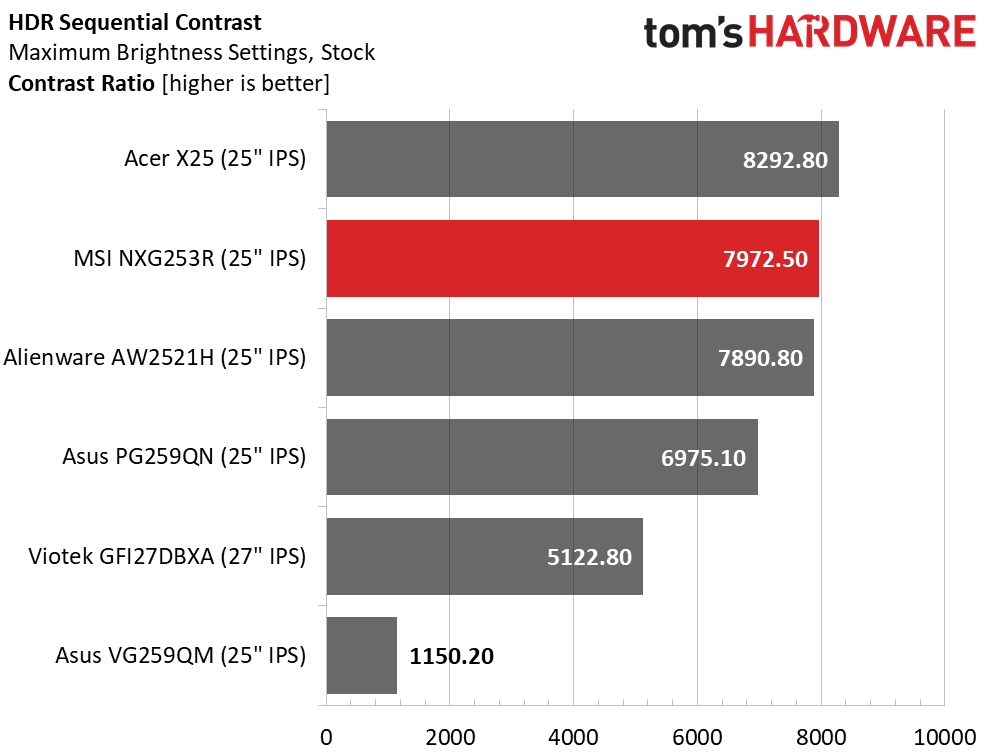Why you can trust Tom's Hardware
Our HDR benchmarking uses Portrait Displays’ Calman software. To learn about our HDR testing, see our breakdown of how we test PC monitors.
HDR isn’t necessarily a deciding factor when contemplating a 360 Hz monitor. But for the money, we expect the feature to be well-implemented. Thankfully, the NXG253R does it right.
HDR Brightness and Contrast



All six displays are rated for 400 nits brightness and exceed that figure. The Viotek is on top with over 486 nits output, but the NXG253R isn’t far behind at 448 nits. All four 360 Hz screens deliver low black levels, thanks to variable backlight features.
The MSI nearly wins the day and is only a fraction behind the Acer X25. With a contrast ratio of almost 8,000:1, it delivers a lot of pop with HDR games. We used the middle variable backlight setting and enjoyed a great HDR picture.
Grayscale, EOTF and Color


In HDR mode, the NXG253R locks out all image controls. We could still change picture modes in the OSD, but there was no effect. Brightness and contrast are unavailable, but you can turn off the variable backlight if you wish. Then, contrast reverts to around 1,000:1. We wondered if that would improve control response, but our tests proved that there was no difference.
The variable backlight does not impact speed in any measurable way. In any case, HDR grayscale tracking is good with just a little blue tint around the 65% tone map transition point. This error is hard to spot in actual content. The EOTF luminance curve tracks slightly dark up to 40%, where it becomes a tad too light. Again, this was hard to spot when playing games. We ran this test using the variable backlight, so some fluctuation is normal.
In the HDR color test, you can see the NXG253R falls short of covering the DCI-P3 gamut. This is no different than any other 360 Hz display. Saturation points are a little over until the monitor runs out of color around 80% red saturation and 80% green saturation. On the other hand, blue, magenta and yellow are fully realized.
Get Tom's Hardware's best news and in-depth reviews, straight to your inbox.
Current page: HDR Performance
Prev Page Grayscale, Gamma and Color Next Page Viewing Angles, Uniformity, Response and Lag
Christian Eberle is a Contributing Editor for Tom's Hardware US. He's a veteran reviewer of A/V equipment, specializing in monitors. Christian began his obsession with tech when he built his first PC in 1991, a 286 running DOS 3.0 at a blazing 12MHz. In 2006, he undertook training from the Imaging Science Foundation in video calibration and testing and thus started a passion for precise imaging that persists to this day. He is also a professional musician with a degree from the New England Conservatory as a classical bassoonist which he used to good effect as a performer with the West Point Army Band from 1987 to 2013. He enjoys watching movies and listening to high-end audio in his custom-built home theater and can be seen riding trails near his home on a race-ready ICE VTX recumbent trike. Christian enjoys the endless summer in Florida where he lives with his wife and Chihuahua and plays with orchestras around the state.
-
helper800 Reply
Even if we had them right now they would be nearly useless. Even CS:GO only gets about 500-550 fps with the best hardware available. Anything in excess of that is useless on a monitor at 1000hz refresh rate.dimar said:How long before we get 1GHz screens? -
escksu Replydimar said:How long before we get 1GHz screens?
I guess you meant 1khz, 1ghz is 1 billion frames per sec. -
Chrys Reply
I was laughing when I read that. I just took it as going to the absurdly far extreme.escksu said:I guess you meant 1khz, 1ghz is 1 billion frames per sec. -
dimar Reply
You're totally correct! I meant 1 MHzChrys said:I was laughing when I read that. I just took it as going to the absurdly far extreme. -
helper800 Reply
You mean 1 KHz. 1 MHZ is 1,000,000 frames per second.dimar said:You're totally correct! I meant 1 MHz -
mihen We already have screens that refresh every 0.001ms . OLEDs. The issue with OLEDs on refresh rates is down to the 4k native resolution, large screen size, and cable standard. If you run the screen at 1080p, you can go to a very high refresh rate.Reply -
helper800 Reply
Do you have any source material I can read on that? As far as I am aware the response time of the technology has nothing to do with its capabilities of displaying higher Hz refresh rates.mihen said:We already have screens that refresh every 0.001ms . OLEDs. The issue with OLEDs on refresh rates is down to the 4k native resolution, large screen size, and cable standard. If you run the screen at 1080p, you can go to a very high refresh rate.